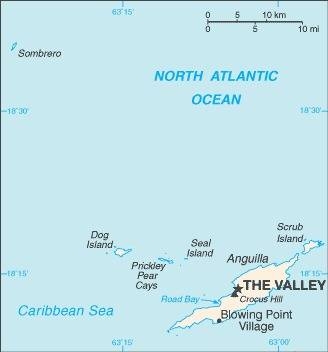Country Summary




Introduction
Background
Colonized by English settlers from Saint Kitts in 1650, Anguilla was administered by Great Britain until the early 19th century, when the island was incorporated into a single British dependency along with Saint Kitts and Nevis. In 1980, Anguilla became a separate British dependency.
Geography
Area
total: 91 sq km
land: 91 sq km
water: 0 sq km
Climate
tropical; moderated by northeast trade winds
Natural resources
salt, fish, lobster
People and Society
Population
18,741 (2022 est.)
Ethnic groups
African/Black 85.3%, Hispanic 4.9%, mixed 3.8%, White 3.2%, East Indian/Indian 1%, other 1.6%, unspecified 0.3% (2011 est.)
Languages
English (official)
Religions
Protestant 73.2% (includes Anglican 22.7%, Methodist 19.4%, Pentecostal 10.5%, Seventh Day Adventist 8.3%, Baptist 7.1%, Church of God 4.9%, Presbyterian 0.2%, Brethren 0.1%), Roman Catholic 6.8%, Jehovah's Witness 1.1%, other Christian 10.9%, other 3.2%, unspecified 0.3%, none 4.5% (2011 est.)
Population growth rate
1.8% (2022 est.)
Government
Government type
parliamentary democracy (House of Assembly); self-governing overseas territory of the UK
Capital
name: The Valley
Executive branch
chief of state: King CHARLES III (since 8 September 2022); represented by Governor Dileeni DANIEL-SELVARATNAM
(since 18 January 2021)
head of government: Premier Dr. Ellis WEBSTER (since 30 June 2020); note - starting in 2019, the title of head of government was changed to premier from chief minister of Anguilla
Legislative branch
description: unicameral House of Assembly (11 seats; 7 members directly elected in single-seat constituencies by simple majority vote, 2 appointed by the governor, and 2 ex officio members - the attorney general and deputy governor; members serve five-year terms)
Economy
Economic overview
small, tourism-dependent, territorial-island economy; very high public debt; COVID-19 crippled economic activity; partial recovery underway via tourism, benefitting from its high amount of timeshare residences; considering reopening oil refinery
Real GDP (purchasing power parity)
$175.4 million (2009 est.)
Real GDP per capita
$12,200 (2008 est.)
Agricultural products
small quantities of tobacco, vegetables; cattle raising
Industries
tourism, boat building, offshore financial services
Exports
$7.9 million (2017 est.)
Exports - commodities
lobster, fish, livestock, salt, concrete blocks, rum
Imports
$186.2 million (2017 est.)
Imports - commodities
fuels, foodstuffs, manufactures, chemicals, trucks, textiles
Exchange rates
East Caribbean dollars (XCD) per US dollar -
Page last updated: Wednesday, November 16, 2022
